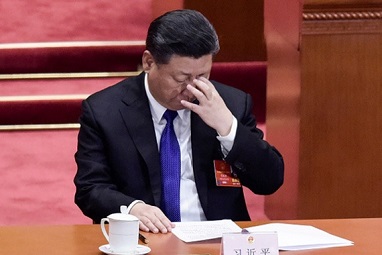From “Lying Flat” to “Lying Down” Chinese Youth’s Pessimism Intensifies

George Magnus, a researcher at the China Center at Oxford University, wrote to the Financial Times that since 2021, the social phenomenon of “laying flat” has taken root among young people in China. The plight of dashed hopes among young Chinese will hurt China’s economy and society.
The article titled “China Can’t Let Unemployed Youth ‘Lie Flat'” pointed out that in a country with the world’s fastest aging population and plummeting birth rate, it should face a labor shortage problem, and the problem should be more pronounced among young people. However, China’s youth unemployment rate hit a record 21.3 percent in June, and some believe the actual figure could be even higher.
As the economy weakens, the supply of good jobs is insufficient, and the labor market is fiercely competitive, many young people have evolved from a “flat” mentality of just getting by in recent years to a more pessimistic “sluggish” attitude. More and more young people have also become full-time children, staying at home to take care of their parents with wages.
The article said that the biggest problem with youth unemployment is what economists call the risk of “hysteresis”, that is, the longer you leave the formal labor market, the harder it is to return to the workplace because skills and qualifications stagnate and decline.
Three reasons why China’s youth unemployment problem is serious:
First of all, according to the Goldman Sachs report, young people are an important consumer group, contributing about 1/5 of the expenditure in urban areas, and if the slightly older age group under the age of 35 is added, it will account for 3/5 of the luxury spending. Weak consumption in China is certainly more complicated than rising youth unemployment, but there is a link.
Second, significant changes in job structure mean that in manufacturing and construction, the proportion of low-wage, low-skilled and temporary jobs has increased. Research by Scott Rozelle, a professor at Stanford University, shows that the ratio of informal to formal jobs was 40:60 15 years ago, but now the ratio has reversed.
The third is three disproportionate issues. One is that the skills acquired by many graduates do not match the needs of employers, especially in engineering, finance and manufacturing. The second is unrealistic job and salary expectations, especially for graduates of higher education.
Furthermore, the lack of overall demand reflects that the Chinese government is too focused on supply-side policies, and that China’s economic development model that focuses on state-owned enterprises is increasingly lacking.
With an additional 12 million college graduates expected to enter the labor force this summer, China watchers will be watching unemployment data more closely as well as economic decisions by the Politburo.
The problem of China’s youth unemployment rate may require drastic changes in the country’s development model to solve it, including expanding the service industry, actively promoting income redistribution, social security, education and tax reform, and shifting the strategic focus back to the private sector, all of which require arduous political transformation.
- report in Liberty Times Net
https://ec.ltn.com.tw/article/breakingnews/4372541
-
Book Shelf
-
 Book Review
DESTINY OF A DYSFUNCTIONAL NUCLEAR STATE
Book Review
DESTINY OF A DYSFUNCTIONAL NUCLEAR STATE
- Book ReviewChina FO Presser Where is the fountainhead of jihad?
- Book ReviewNews Pak Syndrome bedevils Indo-Bangla ties
- Book Review Understanding Vedic Equality….: Book Review
- Book Review Buddhism Made Easy: Book Review
- Book ReviewNews Elegant Summary Of Krishnamurti’s teachings
- Book Review Review: Perspectives: The Timeless Way of Wisdom
- Book ReviewNews Rituals too a world of Rhythm
- Book Review Marx After Marxism
- Book Review John Updike’s Terrorist – a review
-
-
Recent Top Post
-
 Commentaries
Impasse over BRI Projects in Nepal
Commentaries
Impasse over BRI Projects in Nepal
-
 CommentariesNews
Yet another Musical Chairs in Kathmandu
CommentariesNews
Yet another Musical Chairs in Kathmandu
-
 CommentariesTop Story
Spurt in Anti-India Activities in Canada
CommentariesTop Story
Spurt in Anti-India Activities in Canada
-
 NewsTop Story
Nepal: Political Stability Under Threat Again
NewsTop Story
Nepal: Political Stability Under Threat Again
-
 NewsTop Story
Accountability Tryst With 2024 Ballot….
NewsTop Story
Accountability Tryst With 2024 Ballot….
-
 NewsTop Story
What Would “Total Victory” Mean in Gaza?
NewsTop Story
What Would “Total Victory” Mean in Gaza?
-
 CommentariesTop Story
The Occupation of Territory in War
CommentariesTop Story
The Occupation of Territory in War
-
 CommentariesTop Story
Pakistan: Infighting in ruling elite intensifies following shock election result
CommentariesTop Story
Pakistan: Infighting in ruling elite intensifies following shock election result
-
 CommentariesTop Story
Proforma Polls in Pakistan Today
CommentariesTop Story
Proforma Polls in Pakistan Today
-
 CommentariesTop Story
Global South Dithering Away from BRI
CommentariesTop Story
Global South Dithering Away from BRI
-
AdSense code



















